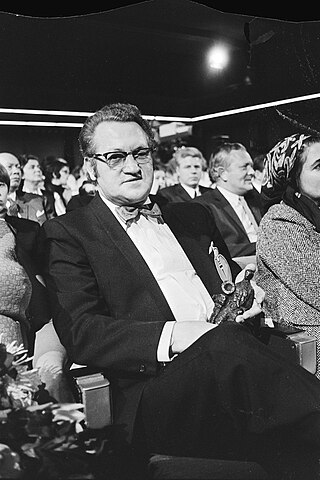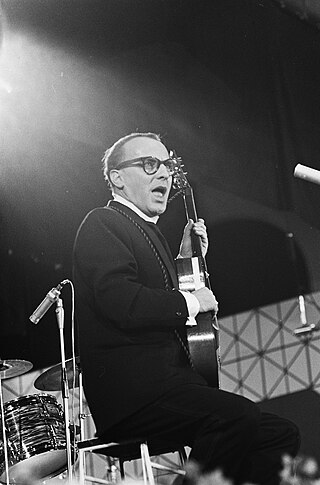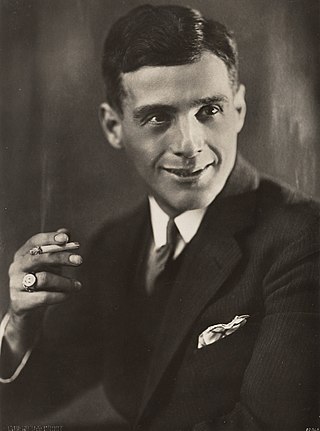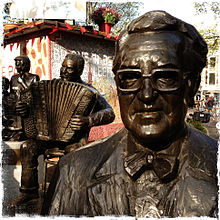
Johnny Jordaan was the pseudonym for Johannes Hendricus van Musscher, a Dutch singer of popular music, in particular the genre known as levenslied, a Dutch variety of the French chanson. He was well known for his songs about the city of Amsterdam, especially the Jordaan district, which he sang in a typical "hiccuping Mokum vibrato", "Mokum" being the Hebrew-derived nickname for the Amsterdam inner city area. In the 1950s, Johnny Jordaan rose almost instantly to the level of national celebrity and became the "uncrowned king of the Jordaanlied", and his hit song "Geef mij maar Amsterdam" is one of the songs Amsterdammers identify with most.

Johan Heinrich (Joop) Doderer was a Dutch actor, well known for his role as the tramp Swiebertje in the eponymous television series. The series ran for 17 seasons between 1955 and 1975, and was broadcast by the NCRV. Besides the role of Swiebertje, Doderer played in dozens of radio and television programs, played the role of Alfred Doolittle in My Fair Lady, acted in Dutch and English movies, and appeared on stage in comedies, musicals, cabaret and dramas.

Anna Maria Geertruida "Annie" Schmidt was a Dutch writer. She is called the mother of the Dutch theatrical song, and the queen of Dutch children's literature, praised for her "delicious Dutch idiom," and considered one of the greatest Dutch writers. An ultimate honour was extended to her posthumously, in 2007, when a group of Dutch historians compiled the "Canon of the Netherlands" and included Schmidt, alongside national icons such as Vincent van Gogh and Anne Frank.

Levenslied is a sentimental Dutch-language subgenre of popular music. Levenslied lyrics can be sweet or bitter, light and sentimental, but also reflective and dark, about subjects such as love, misery and far-away, sunny, exotic holiday places. The darker, more sentimental songs are also known as "smartlap". The levenslied is related to the chanson though for a lower-class audience, like the schlager.

Willem "Wim" Sonneveld was a Dutch cabaret artist and singer. Together with Toon Hermans and Wim Kan, he is considered to be one of the 'Great Three' of Dutch cabaret. Sonneveld is generally viewed as a Dutch cultural icon for his work and legacy in theatre, musicals and music.
Zeemansvrouwen (1930) is a Dutch film directed by Henk Kleinmann, and was intended to be the first ever sound film produced in the Netherlands. Instead, it became the last official Dutch silent film and the last film that would appear between 1930 and 1934. There would be semi-amateur films made in this interim.

The Tars or De Jantjes is a 1934 Dutch comedy film drama directed by Jaap Speyer. The film was a remake of the 1922 film of the same name, which itself was based on a 1920-play by Louis Davids and Margie Morris.
Bij ons in de Jordaan is a 2000 Dutch television series directed by Willem van de Sande Bakhuyzen, a biography of the singer Johnny Jordaan.

Jeroen Willems was a Dutch Golden Calf and Louis d'Or winning film, TV, and stage actor and singer.

Manke Nelis was a Dutch singer in the levenslied genre.

"Aan de Amsterdamse grachten" is a Dutch song by Pieter Goemans. It was written in 1949 but not recorded until 1956, and many times more since then. It is one of the standard songs celebrating the city of Amsterdam, and one of the best-known and most popular songs in the Netherlands.

Louis Davids was a Dutch actor, singer, comedian and revue artist. He is widely considered one of the biggest names in Dutch performing arts.

Tante Leen, real name Helena Kok-Polder, later Helena Jansen-Polder, was a Dutch folk singer from Amsterdam, Netherlands. Together with her friend and colleague Johnny Jordaan, the two together hold the title of "de Beste Stem van de Jordaan".

"Ajax Hup Hup Hup" is a Levenslied song by Tante Leen which was released on His Master's Voice in 1966. It is dedicated to Tante Leen's hometown association football club AFC Ajax from Amsterdam. The song is the A-side to the record "Ajax Hup Hup Hup / Mijn man is Ajaxied" which was released as a 7"-single. The song is the first of many records Tante Leen has released and dedicated to her favorite football club throughout the span of her career.

The Elandsgracht is a street and former canal in Amsterdam, the Netherlands. It runs between the Prinsengracht and the Singelgracht in the Jordaan neighborhood of the Amsterdam-Centrum district. Bridge 169 over the Singelgracht and Bridge 107 over the Lijnbaansgracht connect the Elandsgracht in the direction of the Kinkerstraat. The Elandsgracht is in the west of the Grachtengordel. The Elandsstraat runs parallel to the Elandsgracht. There are houses, shops, cafés and restaurants on the former canal, with parking spaces in the middle.

Margie Morris was an English stage and silent film actress, revue artist, musician, dancer and singer who worked in the Netherlands during the 1910s and 1920s.

The Johnny Jordaanplein, also known as Johnny Jordaan Square is a public square in the center of the Dutch city of Amsterdam which features outdoor sculptures. The square was named for musician Johnny Jordaan and it was dedicated in 1991.


















